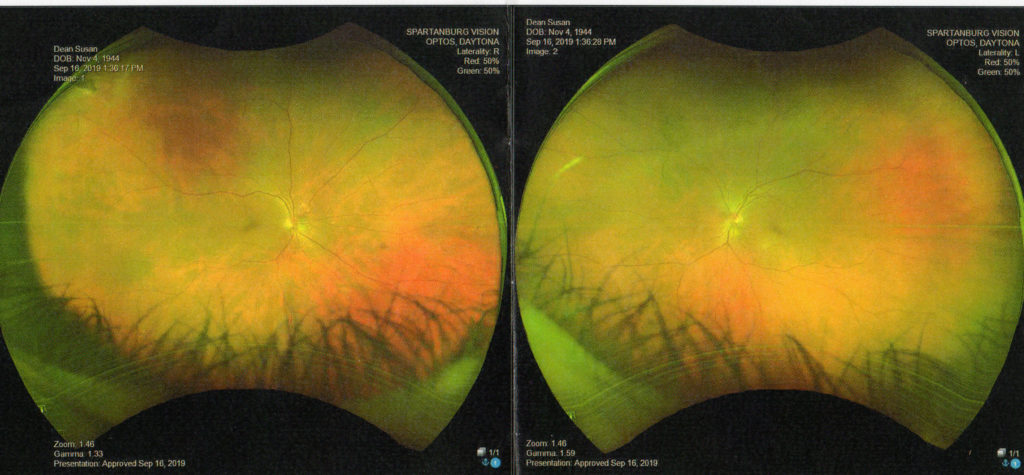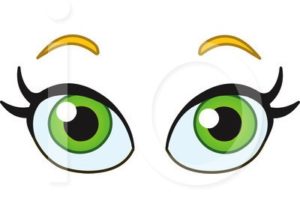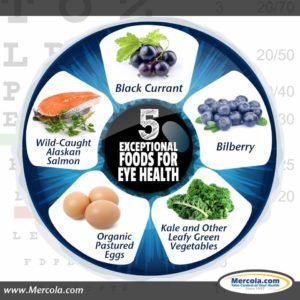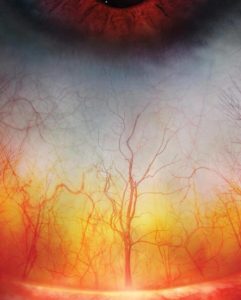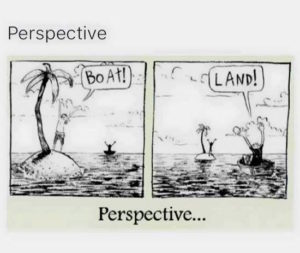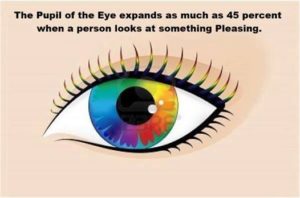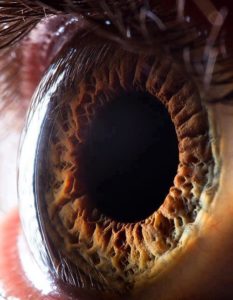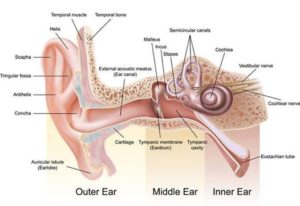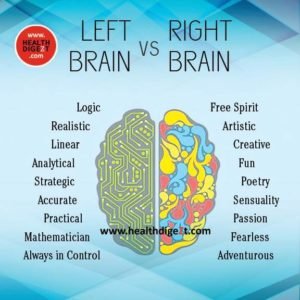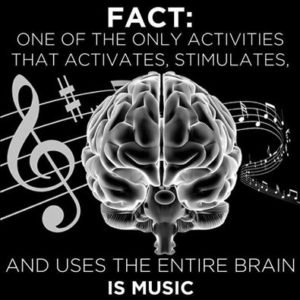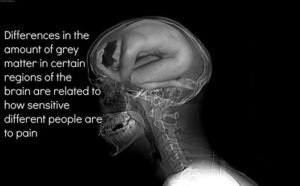Teeth

RIPPERS, NIPPERS, AND GRINDERS
“SMILE and show your Teeth!” Ask kids if babies have teeth. When first born you don’t have teeth but depend on milk from a bottle or breast like all other mammals. There is always an exception to everything and once I saw a newborn with a full set of baby teeth. In a few months gums will get sore and teething usually begins. Babies are given teething biscuits or a cold teething ring to help the discomfort. Teeth are alive and need nutrition (calcium from dairy products and fluoride, a natural element) to stay alive and grow healthy. TEETH are made of the hardest substance in the body and remain when skin and bones have disappeared.
Babies are born with no teeth but have the beginnings of teeth before they are born. At about 5-6 months teething begins. The first teeth (primary teeth) are in by 2½ to 3 yrs. old. Primary teeth are pushed out by permanent teeth at the age of 5-6. By 14 we usually have a full set of 28 permanent teeth. Wisdom teeth come in about 20 yrs. The 20 primary teeth help permanent teeth erupt in their normal positions. Permanent teeth form close to the roots of the primary teeth and by the time primary teeth fall out most of the root has been dissolved.
The tooth above the gum is the CROWN. The part below the gum is the ROOT. The crown is covered with ENAMEL the hardest tissue in the body and protects the tooth. DENTIN makes up most of the tooth and is hard, yellowish, and bonelike and protects the soft PULP inside. The pulp contains the nerves and blood and lymph vessels that keep it alive and healthy. The PULP is how the tooth receives nourishment and transmits signals to the brain. Dentin carries some of the nerve fibers that tell you when something is wrong inside the tooth. Blood vessels and nerves enter the tooth through the ROOT CANAL. As most teeth mature, the root canal closes and the pulp is sealed off. These teeth are “rooted”. In “Rootless” teeth the root canal remains open and the tooth continues to grow indefinitely. RODENT incisors are “rootless” ever growing teeth. The molars of dogs and humans are rooted.
The DENTIN and the PULP go into the ROOT of the tooth. CEMENTUM that is like your body’s glue holds the roots of the teeth in the jawbone. A cushioning layer called the periodontal ligament sits between the cementum and the bone and connects the two.
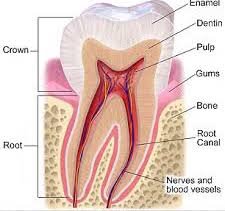
Teeth are present in most vertebrates (exceptions are turtles and modern birds). A significant distinction of mammals is that mammalian teeth are restricted to 3 bones = maxillary, premaxillary, and dentary. The teeth of most vertebrates are replaced throughout the animal’s life. This process doesn’t work well for animals that depend on occlusion (how the teeth fit together) for chewing. It is possible to estimate the age of an animal by determining if primary teeth are present and which ones, or by the amount of wear on the molars. Toothed whales have a single set of teeth.
The Labial teeth are outside close to lips. Lingual are next to tongue and occlusal is where a tooth meets another tooth surface. The efficiency of the mouth to prepare food for digestion depends on the shape and size of the teeth and how they are used. Different mammals have different ways of chewing. Teeth are worn away as they function and form wear facets that appear striated as teeth meet repeatedly in same pattern. Many mammals have fairly flexible articulation and move their jaws in a combination of motions. Guinea pigs slide their jaw forward to grind their food. Some carnivores can only chew up and down such as wolves. Different styles of chewing require different arrangements of the muscles.
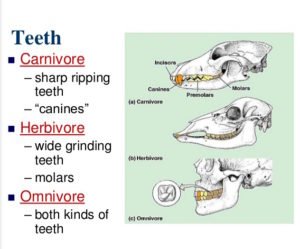 There are 4 kinds of teeth:
There are 4 kinds of teeth:
INCISORS cut and are the most anterior front teeth. In many animals these teeth are used for pincers for grasping or picking in feeding and grooming. Some are MODIFIED to form chisels for gnawing often with a gap (diastema) as in rodents, rabbits, and pikas. There are the scalpel incisors of vampire bats, the tusks of elephants, and the shovel-like lower incisors of hippos, and the lateral incisors of some carnivores like bears, which resemble small stabbing canine teeth.
CANINES (“eye teeth”) tear. When present in mammals (often absent) they are the first tooth in the maxilla, are moderately to very long with a single cusp and 1 root. They are used for stabbing and holding prey. They are usually missing or reduced in size in herbivores. Some species use them as weapons and some animals have huge canines as the musk deer, narwhal, babyrousa, and baboons.
PREMOLARS crush. They lie posterior to the canines and vary greatly in size from a tiny peg in a shrew to a massive crushing organ in a sea otter or wolf. Usually they are smaller and simpler than molars. Premolars are deciduous (there is a milk set)
MOLARS grind. They are not replaced but exist only as adult teeth. They are the most posterior teeth in the jaw. We are considered an adult when eruption is complete. Molars vary greatly in size, shape, and function.
The # of teeth and type of teeth in an animal’s mouth tell a lot about it’s past. In toothed whales the # of teeth has increased, however in most mammals the # of teeth has been reduced in evolutionary history.
TEETH HELP:
1. Shape the face and jaw and are the structural support of the facial muscles for expression.
2. Play a key role in the digestive system to get and chew food (MASTICATION)
3. Baby teeth guide permanent teeth into position
4. The teeth, lips, and tongue are essential for speaking or singing.
5. Used for grooming.
6. Used for defense
The 32 permanent teeth are:
8 incisors are cutters or nippers and have 1 root
4 canines are tearers or rippers and have 1 root
8 premolars are grinders and have 1 root
8 molars are grinders. Molars in the top jaw have 3 roots. Molars in bottom jaw have 2 roots.
4 wisdom teeth grow in about the age of 20
Humans are DIPHYODONTS meaning they develop 2 sets of teeth. Rotting food, bacteria, and plaque causes DECAY. HALITOSIS is bad breath from not cleaning your mouth, food rotting in your mouth, decay, or from certain medications. PERIODONTAL Disease of the gums can be a cause of bad breath. What to do: keep mouth clean by brushing teeth, flossing, and rinsing with mouthwash. PLAQUE is a clear film that sticks to the teeth and acts like a magnet for bacteria and sugar. Bacteria break the sugar down into acids that eat away tooth enamel causing holes called cavities. Plaque also causes GINGIVITIS = a gum disease where the gums become red, swollen and sore. Some bacteria in the mouth are helpful and some are harmful.
Before toothpaste people used ground up chalk or charcoal, lemon juice, ashes. About 100 yrs. ago someone invented a mint paste to clean teeth. When you brush you need a pea size bit of toothpaste and spit it out after brushing – don’t swallow it.
Fluoride helps make teeth strong and protects them from cavities. Dentists may treat teeth with topical fluoride or you may take a vitamin with fluoride. Too much fluoride can cause tooth discoloration. Discoloration can also occur from prolonged use of antibiotics. Fluoride is a natural element found in many things like water or food. It makes stronger enamel. Topical fluoride makes the enamel stronger and more resistant to acid. Some toothpaste has fluoride.
EXPERIMENT:
Fluoride rinse solution from dentist
2 eggs
1 bottle of white vinegar
3 containers
Pour 4“ fluoride solution in 1 container and put egg in to soak for 5 minutes. Pour 4“ of vinegar in other containers. Put the eggs in the vinegar. The egg without fluoride will start to bubble.
KEEP YOUR TEETH HEALTHY BY:
Brush 2 times a day
Brush all of your teeth
Use toothbrush with soft bristles and take your time.
Replace your toothbrush when bristles wear out
Flossing your teeth gets rid of food your toothbrush can’t reach.
Visit a dentist at least once a year.
Be careful about what you eat and drink = fruits, vegetables, and water
Bottle mouth or milk bottle decay is when the milk is allowed to bath the teeth for hours. A bottle sucked all day or night can result in pocked, pitted or discolored teeth. Severe cases result in cavities and the need to pull the teeth.
Orthodontic treatment may be needed to correct one’s bite and straighten the teeth. Crooked teeth are harder to clean and more likely to have cavities. Crooked teeth can affect the way a person chews and talks and how the smile looks. Retainers help keep teeth in their position.
Disorders of the Teeth:
CAVITIES happen when bacteria in plaque digest carbohydrates in food and produce acid that dissolves the tooth enamel.
IMPACTED WISDOM TEETH occur when there is not enough room for them to come in. They can damage other teeth, become impacted or infected. You can see them on X-ray. They are usually removed.
MALOCCLUSION is the failure of the teeth to meet properly causing an overbite, underbite or crowding. It can be corrected with Orthodontia
PERIODONTAL DISEASE is when gums and bones become diseased. GINGIVITIS is the inflammation of the gums. There is redness, swelling, and bleeding caused by inadequate brushing and flossing and a buildup of tartar (a hardened film of plaque). If not treated the gums loosen around the teeth and pockets of bacteria and pus form that damage the bone and cause tooth loss.
Materials: A bald baby with no teeth, a teething ring, puzzle of a tooth showing parts, examples of teeth from animals or skulls showing teeth (beaver, cat, shark are good examples), x-rays of teeth especially showing primary and secondary, toothbrush, floss, cast model of human teeth (from a dentist), model of the jaw of a shark showing many rows of teeth, picture to label parts of a tooth, chart to keep for when they brush their teeth. I also have kids echo words that especially use the teeth to make ( f, th, s, v, and z words). You might give them some tongue twisters too!
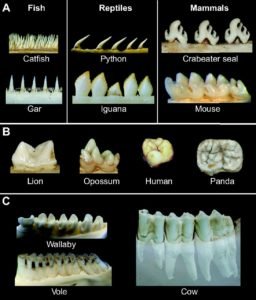
The Importance of Teeth and Chewing Food.
Chewing is a very important part of healthy digestion. Chew your food well. What you get in return is better health. Chew your food completely to be swallowed with ease. Digestion begins with chewing your food.
Chewing triggers the rest of the digestive process. The process of chewing activates messages to the rest of the gastrointestinal system to begin the entire digestive process. Chewing activates taste receptors in the mouth and prompts the nervous system to relay information to the gastric system to optimize the process of digestion. Stimulation of the taste receptors can signal the stomach lining to produce hydrochloric acid that helps in the breakdown of protein. Chewing also signals the pancreas to prepare to secrete enzymes and bicarbonate into the lumen of the small intestines.
Chewing breaks down food molecules to smaller particles. Increases the surface area, reduces esophageal stress and exposes food to saliva for a longer time. Saliva helps lubricate the food making it easier for foods to pass through the esophagus. The enzymes in saliva contribute to the chemical process of digestion. Carbohydrate digestion begins with saliva. The first stage of fat digestion occurs in the mouth.
Incomplete digestion can lead to bacterial growth. When food is not well chewed and food fragments are too big to be broken down, incomplete digestion occurs. Nutrients do not get extracted from the food and it becomes fodder for bacteria in the colon, which can lead to bacterial overgrowth, flatulence, and symptoms of indigestion.
Chewing relaxes the lower stomach muscle. Chewing is directly connected with the movement of food through your digestive tract, and with the movement of food from your stomach to your small intestine. At the lower end of your stomach, there is a muscle called the pylorus. This muscle must relax in order for food to leave your stomach and pass into your small intestine. Sufficient saliva from optimal chewing helps relax the pylorus, and helps your food move through your digestive tract in a healthy fashion.
Recipe for healthy teeth includes regular brushing and flossing, and a diet rich in teeth-healthy foods. Some food choices can contribute to the wear and tear of teeth.
Bacteria in the mouth burn sugars in order to live. The byproduct of this is acid which dissolves tooth enamel and causes cavities. Sticky sugary foods are bad for teeth because they stay on the teeth longer, giving bacteria a chance to burn sugars to acid and cause cavities. Foods and drinks that are acidic and sugary add up to double trouble for they have a multiplying effect.
Saliva helps to naturally wash the mouth of food particles and can keep food from sticking to teeth. Anything that stalls saliva production is not ideal for tooth health either.
Teeth brushing or mouth rinsing after consumption helps prevent decay. Avoid foods that combines sugar, acid and stickiness such as our, chewy candies like Starburst and Skittles. Brushing too soon after a highly acidic or sugary meal can actually cause additional damage to teeth, as the enamel of is softened immediately following contact with “bad” food. Wait 20 to 40 minutes before brushing. Saliva has a neutralizing effect on acid because it contains bicarbonate. It also has calcium and phosphate that help to “re-mineralize” the tooth’s surface.
GOOD FOR THE TEETH:
Cheese, sugar free gum, pears (most acid neutralizing), yogurt, and sesame seeds reduce plaque and help re-mineralize teeth. Cheese is low in sugar and acid, high in calcium, and contains casein, a protein found in milk that is particularly useful for fortifying the tooth’s surface. Dentists may prescribe a re-mineralizing paste called MI Paste made from casein. Parmesan cheese is recommended as a remedy against the degrading effects of acid exposure that accompanies frequent vomiting, often experienced by pregnant women or cancer patients undergoing chemotherapy.
BAD FOR THE TEETH:
Sugary drinks, dried fruit, hard candy, alcohol, citrus acidic foods, starchy foods like bread and potato chips that stick to teeth, coffee.





